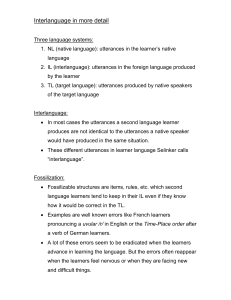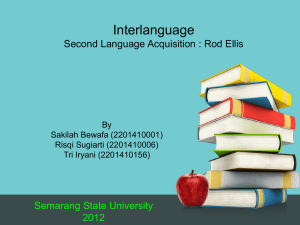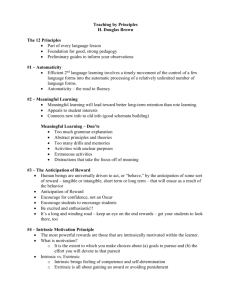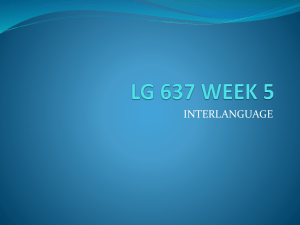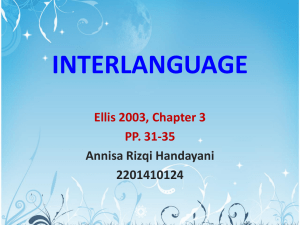English 418 Second Language Acquisition Session Fourteen, Part
advertisement
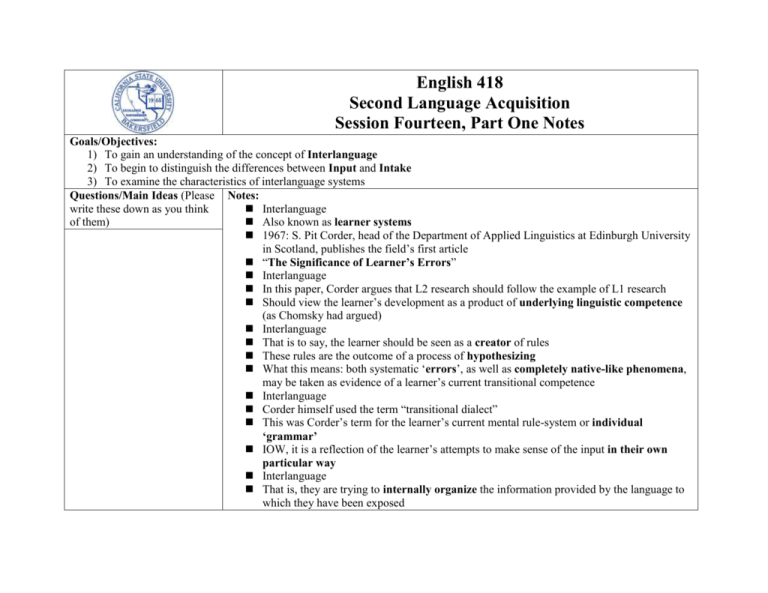
English 418 Second Language Acquisition Session Fourteen, Part One Notes Goals/Objectives: 1) To gain an understanding of the concept of Interlanguage 2) To begin to distinguish the differences between Input and Intake 3) To examine the characteristics of interlanguage systems Questions/Main Ideas (Please Notes: write these down as you think Interlanguage of them) Also known as learner systems 1967: S. Pit Corder, head of the Department of Applied Linguistics at Edinburgh University in Scotland, publishes the field’s first article “The Significance of Learner’s Errors” Interlanguage In this paper, Corder argues that L2 research should follow the example of L1 research Should view the learner’s development as a product of underlying linguistic competence (as Chomsky had argued) Interlanguage That is to say, the learner should be seen as a creator of rules These rules are the outcome of a process of hypothesizing What this means: both systematic ‘errors’, as well as completely native-like phenomena, may be taken as evidence of a learner’s current transitional competence Interlanguage Corder himself used the term “transitional dialect” This was Corder’s term for the learner’s current mental rule-system or individual ‘grammar’ IOW, it is a reflection of the learner’s attempts to make sense of the input in their own particular way Interlanguage That is, they are trying to internally organize the information provided by the language to which they have been exposed Corder argued that the L2 learner may well have a ‘built-in syllabus’, that is “an internally programmed sequence for learning various aspects of the target grammar” Interlanguage This sequence may or may not coincide with the external syllabus imposed on him or her by the teacher Hence, learners will follow a sequence of development (the built-in syllabus) because of, or in spite of, the sequence imposed upon them from the outside Interlanguage The teacher, not understanding this built-in syllabus, may introduce a rule at a particular time But, according to this view, that learner may not actually be able to learn this rule properly unless he or she is ‘ready’ for it (that is, being at the appropriate point in the built-in learning program) Interlanguage Early teaching of a late-learnable form, then, would be a waste of time Which may make the learner appear stupid or stubborn This, in turn, leads to a distinction between input and intake Input is simply anything that the learner is presented with Interlanguage Intake is what the learner is actually ready to process, that is, what they actually are able to internalize Intake is determined by the supposed internal program Hence, at any given time, the learner, like it or not, is ignoring certain aspects of the input Interlanguage This input should, in principle, inform him or her about the target grammar, but the learner is not yet prepared to be informed This, in turn, has another interesting prediction: Correct, native-like behavior cannot necessarily be interpreted as genuine attainment of the native-speaker norm Interlanguage For example, learners in a formal classroom environment may be induced to produce superficially correct behavior via some teaching technique, like repetition Learners may even, at a later time, be able to reproduce the form verbatim But may not yet have actually internalized the form Interlanguage Thus, in Corder’s view, not only should (systematic) errors be regarded as something other than unwelcome deviations, what looks like “correct” performance should be regarded as potentially non-native-like IOW, the surface may not reflect what is going on underneath Interlanguage After Corder, two other researchers published similar proposals concerning learner systems William Nemser (1971) proposed that second language development should be seen as a succession of evolving systems Interlanguage These systems take the learner nearer and nearer to the target language And farther and farther from the ‘source’ language The idea here is that learners are not exposed to the complete target system in ‘one blinding flash’ Interlanguage Rather, they process the input that they receive in smaller digestible doses On the basis of this limited input, they can be said to create their own systems to account for what has been processed to date Nemser calls these systems ‘approximative systems’ Interlanguage Larry Selinker (1972) proposed a very similar approach to Nemser Uses the term ‘interlanguage’, which has since become the adopted term The significance here is that at approximately the same time, three independent researchers proposed essentially the same thing Interlanguage That second language errors should be perceived in quite a different way from the negative manner in which teachers (and indeed most learners) traditionally have perceived them All three proposals have three propositions in common They all assume: Interlanguage a) the existence of a complex, creative learning device (LAD); b) internal coherence in the learner’s language system; and c) the independent character of the learner’s system [as contradictory as b and c might seem] Interlanguage Another way to look at it: all three views are essentially anti-behaviorist Learners are seen not simply as being at the mercy of mechanical mother-tongue ‘habits’ All three accounts involve the idea of complex mental processing whereby the linguistic input is organized by the learner into interlanguage systems Interlanguage The learner could be viewed as a creative selector and organizer of input This fit in well with the Chomskyan view of language Helped explain why L2 learners also produced forms that they could not possibly have heard from a native speaker Interlanguage Language input, then, is not seen as being absorbed in total Rather, some is taken in and used as a basis for forming further hypotheses about the L2 structure Therefore, by definition, an IL must be seen as an unstable and not completely consistent entity Interlanguage Nevertheless, it is an autonomous learner system This forces us away from the teacher perspective which saw the learner’s system as flawed or incomplete In this view, then, an interlanguage is neither an L1 nor an L2 It is something in between Interlanguage Ellis claims that the concept of interlanguage involves the following premises about SLA: 1) The learner constructs a system of abstract linguistic rules which underlies comprehension and production of L2 This system of rules is viewed as a “mental grammar” Interlanguage 2) The learner’s grammar is permeable That is, the grammar is open to influence from the outside, for example through input It is also influenced from the inside, for example through omission, overgeneralization, and transfer errors Interlanguage 3) The learner’s grammar is transitional Learners change their grammar from time to time by adding rules, deleting rules, and restructuring the whole system which results in an interlanguage continuum That is, learners construct a series of mental grammars as they gradually increase the complexity of their L2 knowledge Interlanguage For example, initially learners may begin with a very simple grammar where only one form of the verb is represented But over time, they add other forms, gradually sorting out the functions that these verbs can be used to perform Interlanguage 4) Some researchers have claimed that the systems that learners construct contain variable rules That is, they argue that learners are likely to have competing rules at any one stage of development Interlanguage 5) Learners employ various learning strategies to develop their interlanguages The different kinds of errors learners produce reflect different learning strategies Interlanguage 6) The learner’s grammar is likely to fossilize That is, learners stop learning while their internalized rule system contains rules different from those of the TL Selinker estimates only five percent of learners go on to develop mental grammars equivalent to native speakers Interlanguage The prevalence of backsliding (the production of errors representing an earlier stage of development) is typical of fossilized learners Fossilization does not occur in L1 acquisition and is thus unique to L2 grammars Interlanguage In this view of language learning, learners are to be seen as actively involved in shaping the ‘grammars’ they are learning IOW, learners create their own rules Summary/Minute Paper:
